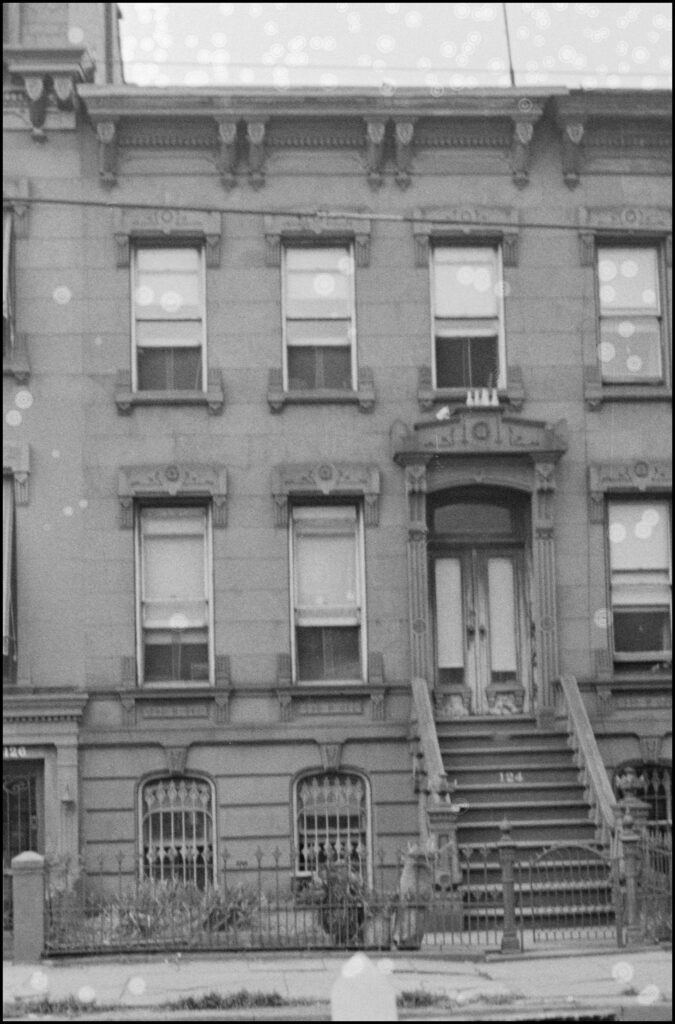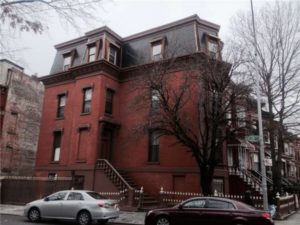 * 1 Verona Place – an 1881/82 brownstone, located in the Bedford section of Bedford-Stuyvesant, this structure was built by Thomas B. Jackson, who had immigrated from England to the U.S. in 1846. Having purchased the entire the entire row of building lots on the east side of Verona Place, Jackson received permits to construct 12 brownstone houses. No. 1 Verona’s lot, though, would be slightly different from all of the other 11 lots in its row. Sitting at a seemingly slight angle on the corner of Verona Place and Macon Street, the shape of the lot was irregular.
* 1 Verona Place – an 1881/82 brownstone, located in the Bedford section of Bedford-Stuyvesant, this structure was built by Thomas B. Jackson, who had immigrated from England to the U.S. in 1846. Having purchased the entire the entire row of building lots on the east side of Verona Place, Jackson received permits to construct 12 brownstone houses. No. 1 Verona’s lot, though, would be slightly different from all of the other 11 lots in its row. Sitting at a seemingly slight angle on the corner of Verona Place and Macon Street, the shape of the lot was irregular. 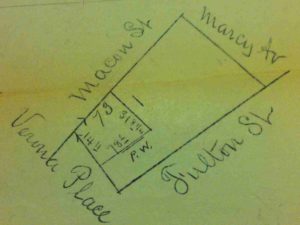 It would measure 31’ 8 ¼” X 78’ 1” X 14’ 11,” and have a much smaller backyard that the other structures due primarily to how Jackson parceled the other lots he had purchased next to it on Macon Street. The first owner of the property was William H. Dole of Dole Brothers, Hops and Malt Merchants, who would purchase the house in 1884 for $10,500. Dole’s wife conveyed the house in 1901 to two widowed sisters who would possess the property for 40 years. In 1941, the house came into possession of its first African-American owners, the Gloster family. The Glosters, a family filled with medical professionals, were royalty in the Bedford-Stuyvesant section. Edna Gloster, the first member of the family to own the property, had been a nurse. Her son, Cecil C. Gloster, to whom she conveyed the property, had received his doctorate at New York University and performed his post doctorate at Harvard Medical School. The next family to own the property, George and Vernel Seymour, would possess it for longer than anyone – almost 50 years, selling it, at last, to a development firm in 2015.
It would measure 31’ 8 ¼” X 78’ 1” X 14’ 11,” and have a much smaller backyard that the other structures due primarily to how Jackson parceled the other lots he had purchased next to it on Macon Street. The first owner of the property was William H. Dole of Dole Brothers, Hops and Malt Merchants, who would purchase the house in 1884 for $10,500. Dole’s wife conveyed the house in 1901 to two widowed sisters who would possess the property for 40 years. In 1941, the house came into possession of its first African-American owners, the Gloster family. The Glosters, a family filled with medical professionals, were royalty in the Bedford-Stuyvesant section. Edna Gloster, the first member of the family to own the property, had been a nurse. Her son, Cecil C. Gloster, to whom she conveyed the property, had received his doctorate at New York University and performed his post doctorate at Harvard Medical School. The next family to own the property, George and Vernel Seymour, would possess it for longer than anyone – almost 50 years, selling it, at last, to a development firm in 2015.
* 124 Malcolm X Boulevard – a Neo-Grec brownstone, located in the Bedford-Stuyvesant section of Brooklyn, this property was constructed by department store magnate, Henry Batterman, on farm land once owned by the Delmonico family of Delmonico’s Restaurant fame. Batterman had just built his crown jewel Brooklyn store, H. Batterman’s, nearby on Broadway and Flushing Avenue, when he followed it with the development of a row of 10 brownstones on the east side of Reid Avenue (the old name for Malcolm X Blvd), between Lexington Ave and Quincy Street – one of which he kept for his family. Early occupants of No. 124 were doctors who also ran their medical businesses out of the house. These doctors were, however, connected with scandals of fraud and infidelity which tainted the residents as well as the house. Later – rather unassuming – occupants found their extended family (living next door at No. 122) associated with a distinct type of Bolshevism, that connected to Leon Trotsky, the Marxist revolutionary – one cousin was his personal secretary, another had interviewed Lenin’s wife, and a third was the lover of the man who assassinated the Communist leader.
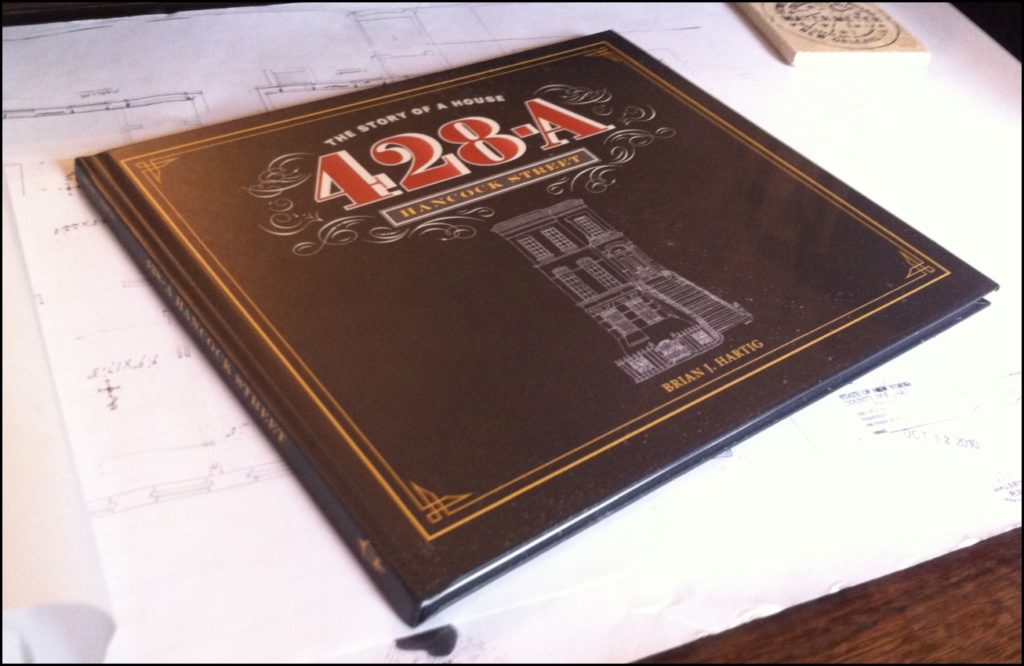
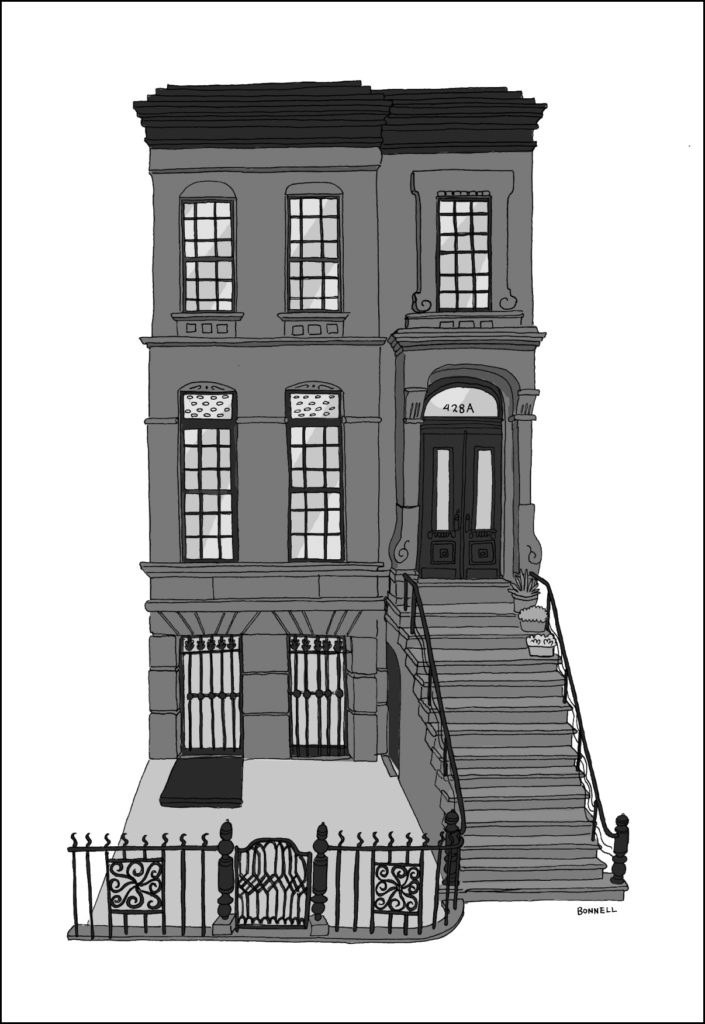 * 428-A Hancock Street – a Renaissance Revival brownstone rowhouse, located in the Stuyvesant Heights section of Bedford-Stuyvesant, this building was constructed by architect/fire-escape designer and one-time Brooklyn Buildings Commissioner Wesley C. Bush. Constructed on the one-time farmland of Rem Lefferts, No. 428-A went up in 1888, the year of the historic Blizzard of 1888, and was conveyed the following year to a successful department store owner. The property would go on to be owned by a fire insurance underwriter (who accumulated a small fortune), a local grocer and his large family, and a Swiss watch case designer, before becoming a part of the inventory of a number of real estate speculators in the 1950s and ’60s. The house’s unfortunate claim to fame was that a flipper who purchased it in the 1990s, was none other than “Trump’s Professor” – a man who helped start the then-real estate investor Donald J. Trump’s Trump University. This owner eventually went to prison for real estate fraud. The property recently underwent a renovation and is now a model home on the block, a 90-page book about its history having been published in 2018.
* 428-A Hancock Street – a Renaissance Revival brownstone rowhouse, located in the Stuyvesant Heights section of Bedford-Stuyvesant, this building was constructed by architect/fire-escape designer and one-time Brooklyn Buildings Commissioner Wesley C. Bush. Constructed on the one-time farmland of Rem Lefferts, No. 428-A went up in 1888, the year of the historic Blizzard of 1888, and was conveyed the following year to a successful department store owner. The property would go on to be owned by a fire insurance underwriter (who accumulated a small fortune), a local grocer and his large family, and a Swiss watch case designer, before becoming a part of the inventory of a number of real estate speculators in the 1950s and ’60s. The house’s unfortunate claim to fame was that a flipper who purchased it in the 1990s, was none other than “Trump’s Professor” – a man who helped start the then-real estate investor Donald J. Trump’s Trump University. This owner eventually went to prison for real estate fraud. The property recently underwent a renovation and is now a model home on the block, a 90-page book about its history having been published in 2018.
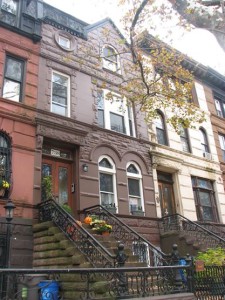 * 738 Macon Street – an 1892 brownstone, located in the Stuyvesant East section of Bedford-Stuyvesant, this structure was built by Wilfred “Lucky 13” Burr, and has been owned by seven families through its 122-year existence. Designed by Architect Amzi Hill, the house was initially meant to be a 3-story structure. After falling into foreclosure several times before the structure was completed, however, the building and lot were finally purchased and structure completed in 1893. After “Lucky 13” purchased the building in a foreclosure tax sale, he completed the building by adding an additional story to the house, and, in the process, turning a 9-room house into a 13-room house. Additionally, the house became the 13th house on the block. Subsequent to the first owner purchasing the house, an odd series of deaths occurred – one each year for five consecutive years – which caused some to feel that the house was cursed (this story, incidentally, has become the basis for an episode of the HGTV series, “Who’s Lived in My House?”). The expansive history of this property turned up more than 350 pages of information (stories, pictures, official documents, architectural drawings, &c.) related to the house, which formed the material for The Brownstone Detectives’s first House History Book.
* 738 Macon Street – an 1892 brownstone, located in the Stuyvesant East section of Bedford-Stuyvesant, this structure was built by Wilfred “Lucky 13” Burr, and has been owned by seven families through its 122-year existence. Designed by Architect Amzi Hill, the house was initially meant to be a 3-story structure. After falling into foreclosure several times before the structure was completed, however, the building and lot were finally purchased and structure completed in 1893. After “Lucky 13” purchased the building in a foreclosure tax sale, he completed the building by adding an additional story to the house, and, in the process, turning a 9-room house into a 13-room house. Additionally, the house became the 13th house on the block. Subsequent to the first owner purchasing the house, an odd series of deaths occurred – one each year for five consecutive years – which caused some to feel that the house was cursed (this story, incidentally, has become the basis for an episode of the HGTV series, “Who’s Lived in My House?”). The expansive history of this property turned up more than 350 pages of information (stories, pictures, official documents, architectural drawings, &c.) related to the house, which formed the material for The Brownstone Detectives’s first House History Book.
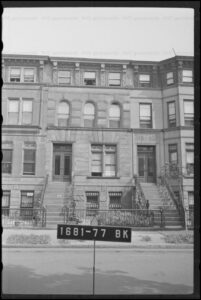 * No. 163 Bainbridge Street – Built in 1892-93, this property is an approximately 130-year-old 3-story & basement 3-family (walk-up apartment) brownstone townhouse situated in the Bedford-Stuyvesant section of Brooklyn, New York. One of five rowhouses constructed by builder David S. Beasley, it was designed in the Romanesque Revival style by architect Magnus Dahlander. It is located 258’ 10” from the corner of Stuyvesant Avenue with a frontage of 19’ 5” and a depth of 100.’ After Beasley completed this brownstone row, he began to sell his houses, conveying No. 163 to its first owner in 1893, who, a few years later, lost it to Beasley in a foreclosure action. It was then purchased by the matriarch of a multi-generational family that occupied it for almost 20 years. Throughout the lifetime of the property, it has been primarily occupied—with the exception of about eight years—by its owners. The first person of color to own the property took possession of it in 1940, after which it was continuously owned by persons of color afterwards, amongst them immigrants from the Caribbean Islands, chiefly Jamaica and the Virgin Islands. Amongst the owners of this property have been the wife of a merchant, a coppersmith, a realtor, an engineer, a real estate speculator, the wife of a bank watchman, a housewife, and a pioneer in natural hair care.
* No. 163 Bainbridge Street – Built in 1892-93, this property is an approximately 130-year-old 3-story & basement 3-family (walk-up apartment) brownstone townhouse situated in the Bedford-Stuyvesant section of Brooklyn, New York. One of five rowhouses constructed by builder David S. Beasley, it was designed in the Romanesque Revival style by architect Magnus Dahlander. It is located 258’ 10” from the corner of Stuyvesant Avenue with a frontage of 19’ 5” and a depth of 100.’ After Beasley completed this brownstone row, he began to sell his houses, conveying No. 163 to its first owner in 1893, who, a few years later, lost it to Beasley in a foreclosure action. It was then purchased by the matriarch of a multi-generational family that occupied it for almost 20 years. Throughout the lifetime of the property, it has been primarily occupied—with the exception of about eight years—by its owners. The first person of color to own the property took possession of it in 1940, after which it was continuously owned by persons of color afterwards, amongst them immigrants from the Caribbean Islands, chiefly Jamaica and the Virgin Islands. Amongst the owners of this property have been the wife of a merchant, a coppersmith, a realtor, an engineer, a real estate speculator, the wife of a bank watchman, a housewife, and a pioneer in natural hair care.
